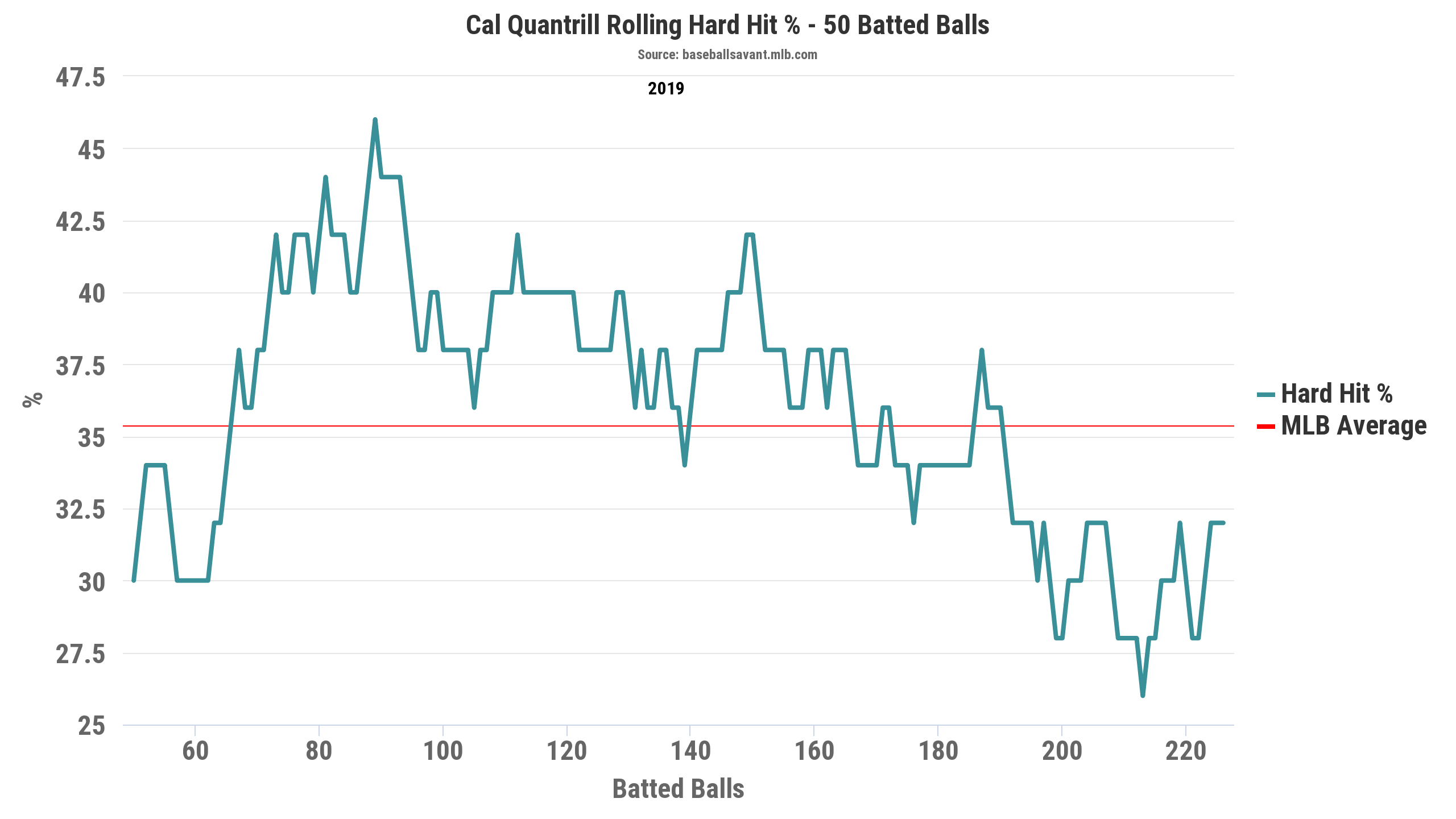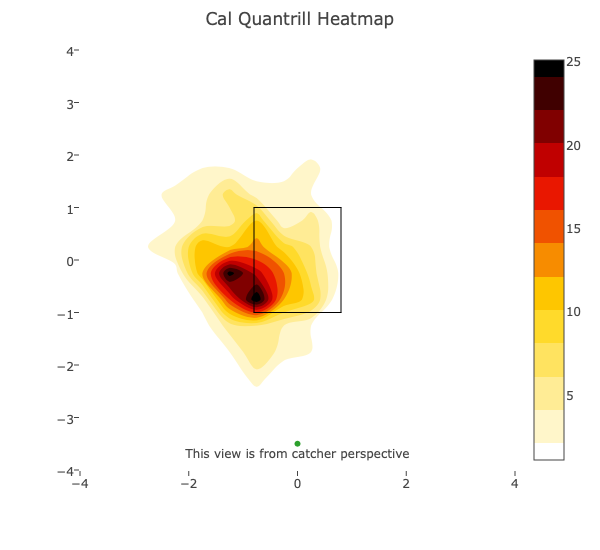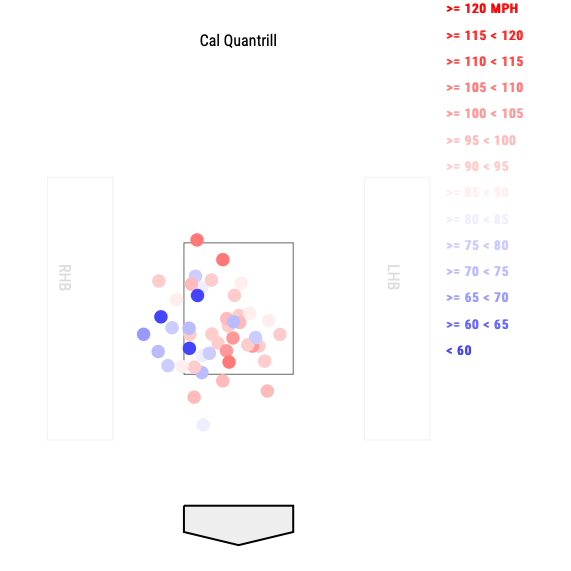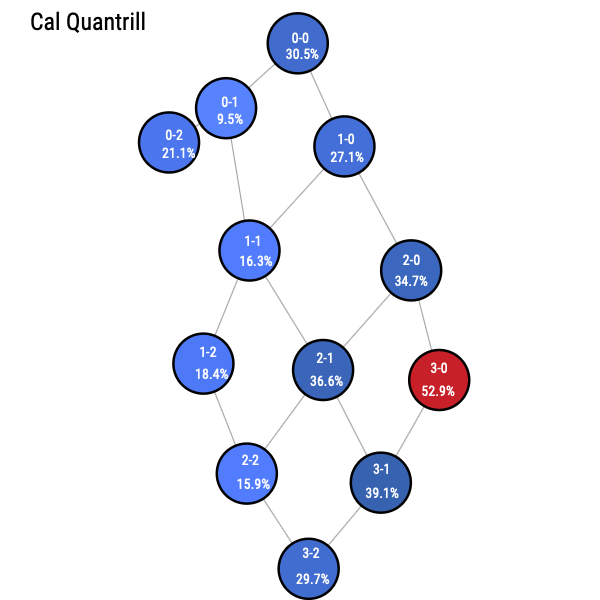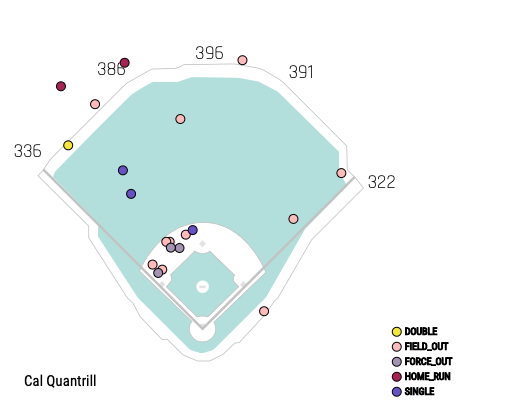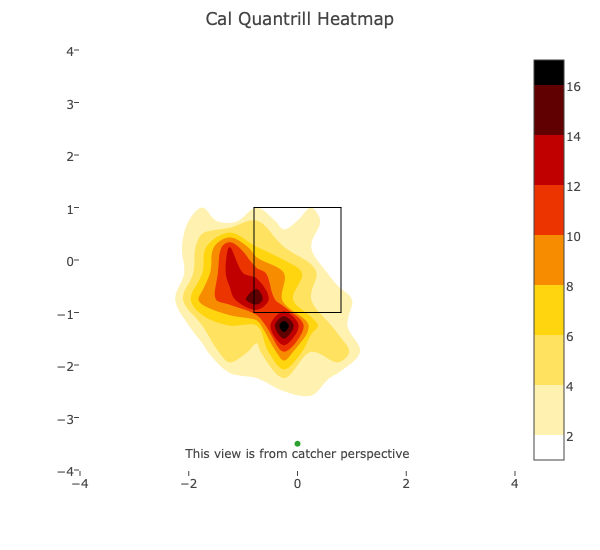The San Diego Padres drafted Cal Quantrill with the eighth overall pick in 2016 after he put together a great college career at Standford University. He slowly made his way through the Padres system and never put up the lights-out numbers that were expected of someone drafted so highly. He made his major league debut May of this year and has turned into one of the Padres best starters. He has a CSW Rate of 27.3 which is the same as Lucas Giolito and Stephen Strasburg, which is not bad company to be around. Before jumping into his pitch mix, it is impressive to note that Quantrill’s hard-hit percentage has been decreasing as the season has gone on.
Two-Seam Fastball
The pitch Quantrill uses the most is a 94 MPH two-seam fastball. I’m not the biggest fan over a sinker but Quantrill’s two-seam is one of the better ones in the league. The league is hitting 0.294 with an exit velocity of 88.7 MPH on the two-seam. Quantrill’s two-seam has a 0.206 BA with an average exit velocity of 83.9 MPH. His two-seam also is a major worm killer with a GB% of 48.8%. While Quantrill uses the pitch more than 30% of the time to righties and lefties, he uses the two-seam 37.4% of the time against left-handed batters. While the GB% is pretty high overall, the two-seam actually gets left-handed batters to lift the ball but very softly. The average exit velocity against left-handed batters is only 80.9 MPH. Looking at the heatmap, it is pretty easy to see why Quantrill has been able to induce weak contact.
Left-handed batters have only made contact on the two-seam 38.7% of the time and when they do, it is quite poor.
He also uses the two-seam more often when he is even or behind in counts. He uses the pitch more than 30% of the time in 0-0, 2-0, 2-1, and 3-0 counts.
This usage has been pretty successful from an exit velocity standpoint. His average exit velocity in these counts, other than 3-0 is less the 86 MPH. The pitch has a 57 wRC+ and is the third-best two-seam by pVAL at 9.6. The pitchers ahead of him in pVAL are Mike Soroka and Julio Teheran. We know that pVAL is not a predictive stat but more of a stat used to explain what happened in the past. The two-seam is a great pitch and Quantrill has been using the pitch more and more as the season has gone on. In May, when he made his debut, he was using the pitch 22% of the time. So far in August, he has up the usage all the way to 50%!
Slider
The slider is the second most used pitch by Quantrill and he almost exclusively uses it against right-handed batters. He uses the slide piece 33.8% of the time against righties and has yet to walk a batter with the offering.
Smartly, Quantrill uses the slider to go down and away to righties and it is very effective. Right-handed batters are hitting 0.162 with 0.351 SLG with a 45.9 K% and 51.4 Whiff%.
https://gfycat.com/yellowishtornhamster
What is also impressive is Quantrill’s ability to not walk batters on the pitch, especially when he throws it outside of the zone so frequently. He has yet to walk a batter on the pitch and his 33.9 K-BB% puts in right around Joe Musgrove and Caleb Smith’s slider.
Right-handed batters have only made contact on the pitch 24.4% of the time and when they do, they pull it on the ground.
The slider also has a 44.8 CSW rate against righties. The pitch is absolutely devastating with a 67 wRC+
Changeup
While Quantrill uses the slider more against right-handed batters, he uses his changeup against left-handed batters. However, Quantrill is using it less now than he was earlier in the season. In the first two months, Quantrill was using the pitch around 30% of the time. Now, he’s moved more to the two-seam and using the changeup only 17% of the time now. Overall, batters are hitting 0.237/0.308/0.407 with a wRC+ of 95. Quantrill throws the pitch out of the zone 64.6% of the time but he is not getting batters to swing and miss often.
In fact, batters are making contact at a 67.8% clip and putting the ball into play about 12.4% of the time. The average exit velocity on all hits was 90.2 MPH but if we remove the two homers, the average exit velocity drops to 87.5 MPH with a launch angle of 2 degrees. That combination of exit velocity and launch angle is not what you are looking for as these are batted balls of the dink-and-dunk variety. In fact, they have a batting average of 0.381, a slugging percentage of 0.429, and 0.350 wOBA.
Four-seam
https://gfycat.com/thunderousamusingant
The pitch gets average vertical movement, with 14.5 inches of drop and above-average side to side movement with 8.3 inches of break. Just like all his other offerings, Quantrill is using his four-seam less now than he was at the beginning of the season. He began using the pitch 22.5% but is now using the pitch 9.7% in August. He is also attacking batters differently. In May, he was throwing the four-seam in the zone 46.3% of the time and getting called strikes 7.4% of the time. Now, he is throwing it in the zone 52.5% of the time and getting called strikes 17.5% of the time. Whiffs have gone up slightly, 19.4% to 21.7%. The average exit velocity has decreased slightly from 84.8 MPH in May to 83.5 MPH in August. All this being said, Quantrill has been walking a fine line with the pitch. In May, he had a wOBA on contact of 0.437 but an xwOBA on contact of 0.376 for a difference of 0.61. Now in August, he has a wOBA on contact of 0.326 with an xwOBA on contact of 0.473 for a difference of -0.146. I am not sure how sustainable his success with the four-seam will be but if he is using it only 9% of the time, he should be able to get away with it.
So what about next year?
I’m pretty sure that Cal Quantrill has been picked up in your league. If not, what are you waiting for? As for next year, I have a feeling Quantrill will be going pretty late in drafts. In fact, he might even be the third pitcher drafted from the Padres, with Chris Paddack and Joey Lucchesi going before him. He is not the type of pitcher us as fantasy players typically go for. To be honest, if this is the case, I can see having him on quite a few of my teams next year. While he is not going to get a bunch of strikeouts, he should be a great asset in the ratio stats.
(Photo by David John Griffin/Icon Sportswire)

